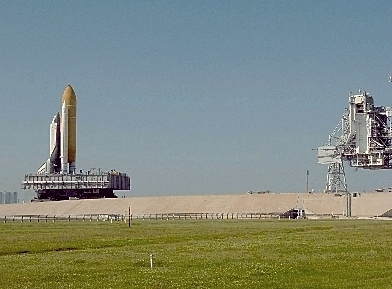
 |
![]() Arrivée au pas de tir
Arrivée au pas de tir
La mission STS-122 de la navette spatiale est vue ici en train d'arriver au pas de tir 394 du Kennedy Space Center, le 10 novembre 2007. Il s'agit d'un vol à destination de la Station Spatiale Internationale. Cette procédure est habituelle à tout vol de la navette spatiale. La navette spatiale est un système qui comprend un "orbiter" -en fait ce que le langage courant appelle la navette- un réservoir extérieur -qui contient le carburant utilisé par les moteurs de l'orbiter- et deux fusées à poudre latérales -qui aident à propulser la navette dans les premières phases du vol. La navette spatiale -l'orbiter c'est-à-dire- est préparé, dans un premier temps, dans l'"Orbiter Processing Facility" (OPF; "le hangar de préparation de la navette") puis il est déplacé au "Vehicle Assembly Building" (VAB) cet immense immeuble qui date du programme Apollo, dans les années 1960. Là, la navette est assemblée au réservoir extérieur et aux deux fusées à poudre. Le tout se situe sur une plate-forme mobile immense, haute comme un immeuble de deux étages, le "Mobile Launcher Platform" (MLP). Cet ensemble, en anglais, est désigné sous le nom de "stack" (car il s'agit de l'assemblage -"stack"- des trois éléments de la navette). Le stack, deux à trois semaines avant le lancement, est enfin déplacé jusqu'au pas de tir. Pour ce faire, on place le MLP sur un grand transporteur chenillé, lequel déplace lentement la navette (moins de 1,6 km/h -1 mile/h). Une fois arrivée au pas de tir, la navette spatiale continue d'être préparée pour le lancement et les équipages pratiquent différents entraînements. On voit, ici, la mission STS-122 parcourir les dernières étapes du trajet. On devine, sur la droite, la "Rotating Service Structure" ("structure de service rotative") qui enserre la navette jusqu'à peu avant le lancement et permet les opérations de préparation. La mission STS-122 va continuer la construction de l'ISS. Elle y amènera le module européen "Colombus", un laboratoire multi-fonctions pressurisé qui sera arrimé au "Node 2" -Harmony, le module américain qui a été apporté à la Station Spatiale par la dernière mission de la navette. La STS-122 devrait s'élancer le 6 décembre 2007. NASA/Kim Shiflett